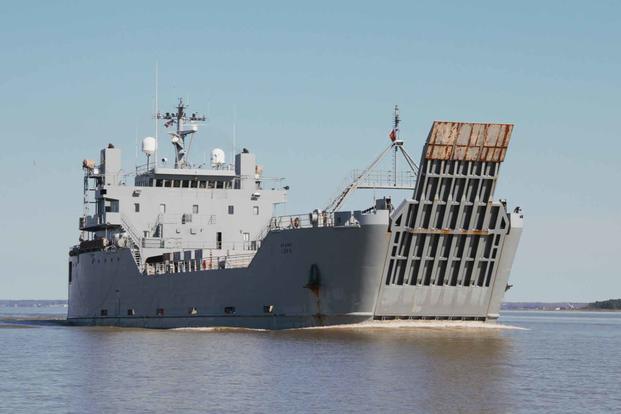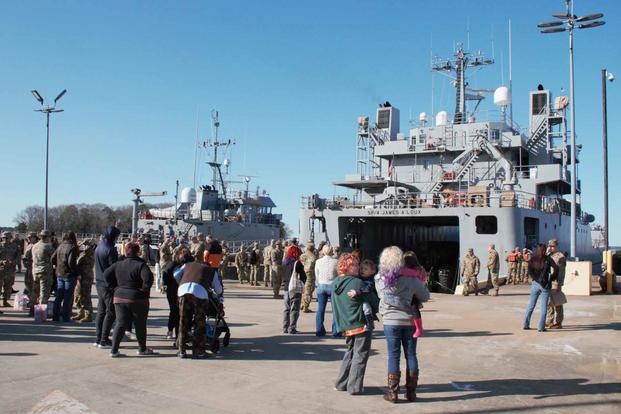FORT EUSTIS, Virginia -- On a small, tucked away pier just off the James River, the sounds of Lee Greenwood and Toby Keith blared over the water as soldiers hugged their kids and spouses and the gantry of a large Army landing ship slowly began to close behind them.
The soldiers were all part of the 7th Transportation Brigade (Expeditionary) -- 7th TBX, for short -- and they were getting ready to man four transportation ships that set sail Tuesday morning bound for Gaza, where months of the Israel-Hamas war have pushed the civilian population to the brink of starvation.
The brigade is set to play a key role in relieving a growing humanitarian crisis in Gaza that has sparked deep concerns around the world. Soldiers with the 7th TBX have been tasked with building a literal bridge across the water to deliver food aid to the Palestinians trapped in the ongoing violence since October.
Read Next: Supply or Die: Sustaining Marines in the High North so They Can Fight and Win a Future War
"We have transported personnel supplies across many waters around the world, and this is no different," their commander, Col. Samuel Miller, told reporters assembled pierside to watch the deployment. "We understand the importance of this mission. ... We will forge across the water to deliver humanitarian assistance."
The four ships -- the Logistics Support Vessel SP4 James A. Loux and Landing Craft Utility Wilson Wharf, Matamoros, and Monterrey -- are the latest to set sail for the Middle East to help set up a temporary pier that President Joe Biden announced at his State of the Union address last week in an effort to get more aid and supplies into the besieged territory.
After roughly 30 days of sailing, the ships will arrive in the Middle East and spend roughly a month setting up the system of two piers -- an offshore pier where civilian ships will offload the aid, and a working or "trident pier" that will be anchored to the shore of Gaza.
These piers are made up of large metal pontoons that are connected together like building blocks, and the trident pier can be anywhere from 800 feet up to 2,000 feet long. A document provided by the Army says that this pier is then “flanked by tugboats or modular causeway ferries and driven or ‘stabbed’ into the shore.”
According to the unit's commanding general, Brig. Gen. John "Brad" Hinson, these soldiers are part of the roughly 500 that will deploy from the 7th TBX to make the plan a reality.
"These types of units like 7th TBX ... they're ready to deploy on very, very short notice," Hinson said.
Miller said the Army's first vessel left "36 hours after the president made that statement in the State of the Union address."
Chief Warrant Officer 3 Benjamin Tate told reporters that he and his soldiers found out about their deployment last week.
"I'm excited -- I get to go do my job," Tate said before adding that "the downside is, I have to leave my family."
"We're extremely proud that we get to participate in humanitarian relief," said the chief warrant officer, who serves as the James Loux's chief engineer. "I know me personally, if my family was in that situation, I'd want somebody to be willing to help."

Army leaders told reporters that aside from recently practicing the pier-building capability during a major exercise last year in Australia, the Army had employed it in 2010 to deliver aid to Haiti and resupply the National Science Foundation in Antarctica last year.
In contrast to a Navy ship deployment, the soldiers on the pier were overwhelmingly enlisted or chief warrant officers -- and much fewer in number.
"Key to this operation ... is our warrant officers and our noncommissioned officers and enlisted soldiers," Miller said.
The James Roux, for example, only has a crew of around 30 people and is led by a warrant officer "vessel master."
In fact, Army officials told Military.com that all four of the vessels that set sail Tuesday were led by either warrants or senior enlisted noncommissioned officers.
Army officials reiterated assertions made by Pentagon officials last week that no U.S. troops will actually go ashore in Gaza.
Miller said anchoring the pier to the beach will require "kind of a digging-out of an area and then some anchoring that we'll need assistance with," but he added that "we don't see any issues with that."
Army officials refused to answer questions about how the security or force protection aspects of the mission will work.
Hinson explained that the plan right now is to have goods arrive on civilian ships to one of two screening locations on shore in the region where they will be screened. Then, they will proceed to the first pier to offload the aid where it will be screened again.
"You will not see any type of civilian vessel that is actually going to the trident pier; they will offload two to three miles away," Hinson explained.
From there, Army watercraft will move the aid to the land-based pier where, according to Hinson, soldiers "will try to keep as much distance as possible away from the shore" but stressed that "our job is to work on this pier and to move rolling stock and rolling cargo from the vessels onto the shore."
Pentagon officials told reporters Friday that ultimately around 1,000 service members will be involved in the operation, and Hinson said that the Navy's Beach Group 1 has been tasked to assist. "They will also have watercraft; they will have working tugs and causeway systems that can pair in to the capabilities that the Army has," he said.
A Navy spokesperson confirmed that "the Navy will deploy Naval Beach Group 1, comprised of units from Amphibious Construction Battalion, Beachmaster Unit 1, and Assault Craft Unit 1, and augmented by the Navy Expeditionary Logistics Support Force" but wasn't able to immediately offer more specifics.
The Navy also announced that it will deploy the USNS Roy Benavidez -- "a Bob Hope-class roll-on, roll-off vehicle cargo ship to assist with logistics and humanitarian response mission tasking."
The Benavidez is typically held in a "reduced operating status" by the U.S. Maritime Administration but can be reactivated within five days, according to Navy officials.
Related: New Military Sealift Operation to Aid Starving Gaza Residents Will Require More than 1,000 US Troops












